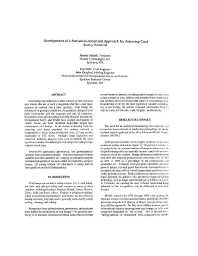Mining Publication: Development of a Statistical-Analytical Approach for Assessing Coal Bump Potential
Original creation date: August 1997
Coal bumps are defined as sudden failures of rock and coal near entries that are of such a magnitude that they expel large amounts of material into a mine opening. Coal bumps are influenced by geologic conditions, the geometric design of coal mine excavations, and the sequence and rate of extraction. Researchers from private industry and the National Institute for Occupational Safety and Health have studied mechanisms of violent failure and have identified individual factors that contribute to coal bumps. In an attempt to develop tools for assessing coal bump potential, the authors initiated a comprehensive study using information from 25 case studies undertaken in U.S. mines. Multiple linear regression and numerical modeling analyses were used to identify the most significant variables contributing to coal bumps (excluding bumps related to fault-slip). Twenty-five geological, geometrical, and geomechanical variables were considered initially. The most important of these variables were then identified as (1) energy as calculated using the mechanical properties of the strata, depth of overburden, and joint density, (2) mining method, (3) pillar factor of safety, and (4) stress gradient and yield characteristics.
Authors: H Maleki, EG Zahl, JP Dunford
Conference Paper - August 1997
NIOSHTIC2 Number: 20022993
Proceedings of the 16th International Conference on Ground Control in Mining, August 5-7, 1997, Morgantown, West Virginia. Peng SS, Holland CT, eds., Morgantown, WV: West Virginia University, 1997 Aug; :304-310
See Also
- 60 Years of Rockbursting in the Coeur D'Alene District of Northern Idaho, USA: Lessons Learned and Remaining Issues
- Behavior of a Coal Pillar Prone to Burst in the Southern Appalachian Basin of the United States
- Coal Bumps and Odd Dynamic Phenomena - A Numerical Investigation
- Deep Cover Pillar Recovery in the US
- Diagnosing and Controlling Moisture-Sensitive Roof in Coal Mines
- Dynamic Failure in Deep Coal: Recent Trends and a Path Forward
- In Situ Estimation of Roof Rock Strength using Sonic Logging
- In-depth Survey Report: Control Technology for Environmental Enclosures - The Effect of Wind Speed Upon Aerosol Penetration Into an Enclosure at Clean Air Filter, Defiance, IA
- Rock Mechanics Investigations at the Lucky Friday Mine (In Three Parts): 1. Instrumentation of an Experimental Underhand Longwall Stope
- Work Practices to Manage Bump Prone Ground
- Page last reviewed: 9/21/2012
- Page last updated: 9/21/2012
- Content source: National Institute for Occupational Safety and Health, Mining Program


 ShareCompartir
ShareCompartir
